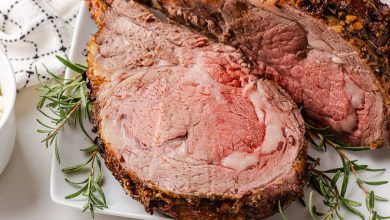Beef Brisket (Whole, Lean, 0″ Fat, All Grades, Cooked, Braised)
Beef brisket, particularly when braised to perfection, is a flavorful and hearty cut of meat that brings warmth to any meal. This rich source of protein and essential minerals makes it an excellent choice for those seeking a nutritious, satisfying dish. Braising the brisket allows the meat to become tender and flavorful, with all the natural juices and nutrients preserved.
Nutritional Information (Per 100g)
| Nutrient | Amount |
|---|---|
| Energy | 218 kcal |
| Protein | 29.75 g |
| Fat | 10.08 g |
| Saturated Fat | 3.63 g |
| Carbohydrates | 0.0 g |
| Fiber | 0.0 g |
| Sugar | 0.0 g |
| Calcium | 6.0 mg |
| Iron | 2.81 mg |
| Magnesium | 23.0 mg |
| Phosphorus | 241.0 mg |
| Potassium | 285.0 mg |
| Sodium | 70.0 mg |
| Zinc | 6.89 mg |
| Copper | 119 mcg |
| Manganese | 0.017 mg |
| Selenium | 24.5 mcg |
| Vitamin C | 0.0 mg |
| Thiamine (Vitamin B1) | 0.07 mg |
| Riboflavin (Vitamin B2) | 0.22 mg |
| Niacin (Vitamin B3) | 3.71 mg |
| Vitamin B6 | 0.29 mg |
| Folate (Vitamin B9) | 8.0 mcg |
| Vitamin B12 | 2.6 mcg |
| Vitamin A | 0.0 mcg |
| Vitamin E | 0.14 mg |
| Vitamin D2 | 0.2 mcg |
Allergen Information
This beef brisket is a meat-based product and contains no common allergens, such as dairy, gluten, or nuts. However, if prepared with marinades or sauces, it’s important to check for any added allergens.
Dietary Preferences
- Gluten-Free: Beef brisket is naturally gluten-free, making it suitable for individuals with gluten intolerance or those following a gluten-free diet.
- Low-Carb: With zero carbohydrates and sugars, this dish is perfect for those following a low-carb or ketogenic lifestyle.
- High Protein: Brisket is an excellent source of high-quality protein, making it ideal for those looking to boost muscle growth or maintain a balanced diet.
- Paleo and Keto Friendly: Due to its lack of carbohydrates and high-fat content, beef brisket fits well into both paleo and keto diets.
Culinary Advice
Beef brisket can be cooked in various ways, but braising is one of the best methods for ensuring a tender, flavorful result. Slow-cooking the brisket in a flavorful broth or marinade helps break down the meat’s connective tissues, resulting in a melt-in-your-mouth experience. Braised brisket pairs wonderfully with a variety of vegetables and can be served with mashed potatoes, roasted carrots, or a fresh salad for a balanced meal. For those following specific diets, such as keto or low-carb, brisket can be paired with non-starchy vegetables like leafy greens or cauliflower.
When preparing brisket, don’t forget to season it with a blend of herbs and spices. A simple combination of garlic, onion, black pepper, and salt will allow the natural flavors of the meat to shine. For an added depth of flavor, consider marinating the brisket overnight with a mix of soy sauce, Worcestershire sauce, and your favorite spices.
Conclusion
Braised beef brisket is a versatile and nutrient-dense dish, perfect for various dietary preferences and packed with high-quality protein and essential vitamins and minerals. Whether served as a main course for a family dinner or used in sandwiches, tacos, or salads, brisket offers a rich, satisfying meal. It’s a great choice for anyone looking to enjoy a hearty, flavorful cut of meat that delivers excellent nutritional benefits, from muscle-building protein to essential minerals like iron, zinc, and potassium.










